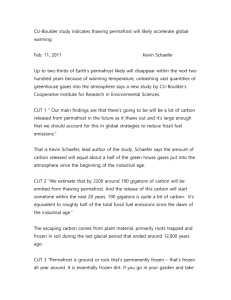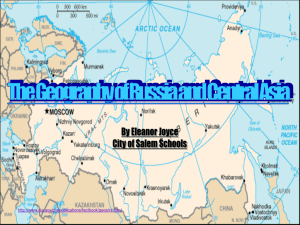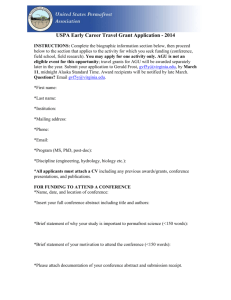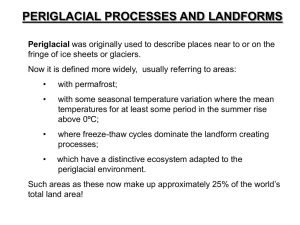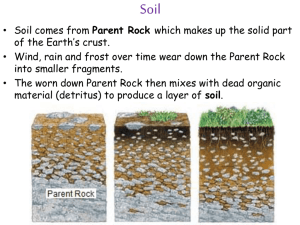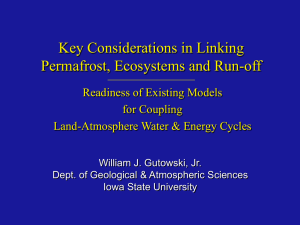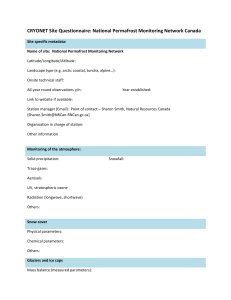CHARACTERISTICS OF SURFICIAL BRIGHTNESS TEMPERATURE ... REFLECTIVE SPECTRUM IN SPORADIC PERMAFROST ...
advertisement
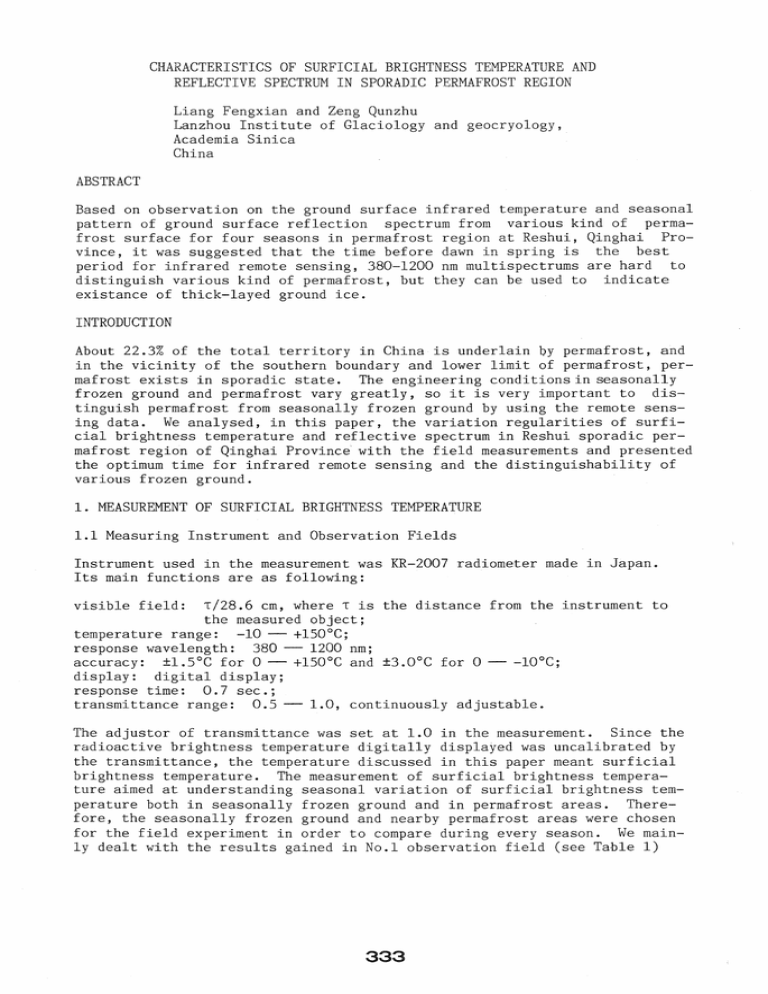
CHARACTERISTICS OF SURFICIAL BRIGHTNESS TEMPERATURE AND
REFLECTIVE SPECTRUM IN SPORADIC PERMAFROST REGION
Liang Fengxian and Zeng Qunzhu
Lanzhou Institute of Glaciology and geocryology,
Academia Sinica
China
ABSTRACT
Based on observation on the ground surface infrared temperature and seasonal
pattern of ground surface reflection spectrum from various kind of permafrost surface for four seasons in permafrost region at Reshui, Qinghai Province, it was suggested that the time before dawn in spring is the best
period for infrared remote sensing, 380-1200 nm multispectrums are hard to
distinguish various kind of permafrost, but they can be used to indicate
existance of thick-layed ground ice.
INTRODUCTION
About 22.3% of the total territory in China is underlain by permafrost, and
in the vicinity of the southern boundary and lower limit of permafrost, permafrost exists in sporadic state. The engineering conditions in seasonally
frozen ground and permafrost vary greatly, so it is very important to distinguish permafrost from seasonally frozen ground by using the remote sensing data. We analysed, in this paper, the variation regularities of surficial brightness temperature and reflective spectrum in Reshui sporadic permafrost region of Qinghai Provinc~ with the field measurements and presented
the optimum time for infrared remote sensing and the distinguishability of
various frozen ground.
1. MEASUREMENT OF SURFICIAL BRIGHTNESS TEMPERATURE
1.1 Measuring Instrument and Observation Fields
Instrument used in the measurement was KR-2007 radiometer made in Japan.
Its main functions are as following:
visible field:
t/28.6 cm, where t is the distance from the instrument to
the measured object;
temperature range: -10 -- +lsO°C;
response wavelength: 380 -- 1200 nm;
accuracy: ±l.soC for 0 -- +lsO°C and ±3.0°C for 0 -- -10°C;
display: digital display;
response time: 0.7 sec.;
transmittance range: 0.5 -- 1.0, continuously adjustable.
The adjustor of transmittance was set at 1.0 in the measurement. Since the
radioactive brightness temperature digitally displayed was uncalibrated by
the transmittance, the temperature discussed in this paper meant surficial
brightness temperature. The measurement of surficial brightness temperature aimed at understanding seasonal variation of surficial brightness temperature both in seasonally frozen ground and in permafrost areas. Therefore, the seasonally frozen ground and nearby permafrost areas were chosen
for the field experiment in order to compare during every season. We mainly dealt with the results gained in No.1 observation field (see Table 1)
333
Table 1.
Type of
frozen
ground
Conditions No.1 Observation Field
Seasonally frozen ground
Seasonally
frozen
ground
Lying on river flood plain,
loose silty sand and sparse
vegetation on the surface
Water content
Spring
26
(%)
Mean annual
ground temp.
(DC)
Summer
30
0.0 -- 2.0
Fall
50
Winter
No data
Permafrost
Lying on high river flood
plain lowland the surface was
covered by thick vegetation
and overlain by turf. Ice
content near permafrost table
ranged from 50-80%
Spring
133
Summer
135
Fall
116
Winter
No data
-0.1 -- -0.5
1.2 Seasonal Variation of Surficial Brightness Temperature
The sun is the thermal radiation source of the earth's surfac~, and the duration and identity of the solar radiation varied periodically from day to
night and season to season.
a. Summer During the period of temperature rise in the day, the temperature
rise of seasonally frozen ground was quicker than that of permafrost. During
the period of temperature lowering, the result was opposite, i.e. the brightness temperature of permafrost was higher than that of seasonally frozen
ground. The surficial brightness temperature of seasonally frozen ground was
higher than that of permafrost at noon, but adverse result could be obtained
at night. Table 1 shows that in permafrost area, the surface was underlain,
by turf water content was large and vegetation was thick, and that in the
seasonally frozen ground, the surface was underlain by coarse-grained soil,
vegetation was sparse and moisture content was lower. Thus, permafrost,
with larger heat capacity in summer, had low temperature during the day and
high temperature at night (Sabins, 1980). Permafrost was characterized by
slow (temperature lowering and rise, low) maximum value at noon, and high
mlnlmum value at midnight. The reasons for these were the evapotranspiration
cooling in the day and the insulation of vegetation at night. (see Fig.l-l)
b. Winter The brightness temperature of permafrost lowered and rose rapidly
and was higher than that of seasonally frozen ground in the day. The curves
of brightness temperature of permafrost and seasonally frozen ground at
night intersected each .other many times in Fig. 1-2 , and no regularities could
be observed. The reason for the phenomenon was that the actual brightness
temperature could reach -20 -- -30 D C which was beyond the instrument measurement range. The fact that the temperature of permafrost was lower than that
in seasonally frozen ground at night had been proved by the mercury thermometer (Fig.1-3).
~
35.0
~
30.0
~
25.0
0.
20.0
:::J
Q)
E
Q)
f-<
C/)
C/)
Q)
c
..c
Of)
~
~
1 Seasonally frozen ground
2 Permafrost
15.0
10.0
5.0
0.0
- 5.0
16:0
20:0
24 :0
4 :0
12:()
16 :0
20:()
24:()
4 : ()
8:0
(Time)
u
'10..
8 Aug.
:::J
if)
9 Aug.
10Aug.
Fig. 1-1. Surficial Brightness Temperature Curves In Summer
20.0
15.0
1 Seasonaliy frozen ground
~
10.0
2 Permafrost
...
:::J
5.0
Q)
I
Q)
0.
f-<
2
\
/
/
E
E
Q)
11\
,r-
0.0
-5.0
C/)
rIl
Q)
c
-10.0
;:
.~ -15.0
...
=
c; - 20.0
'u
t:10..
:::J
if)
~ :::: ~
- 35.0
Fig. 1 -2. Surficial Brightness Temperature
Curves in Winter winter
c. Fall The ground surface thawed in the day and froze at night. Vegetation
dried up, but there was some green color at root. The cooling of evapotranspiration became weaker. At this time, the diurnal variation of temperature of the ground surface belonged to transition type. The temperature of
the ground surface was similar to that in summer, but similar to that in
winter at night (Fig.I-4).
d. Spring The ground began to thaw and vegetation sprouted. The variation
of surficial brightness temperature was similar to that in summer. Permaforst had features of slow temperature rise and lowering, and of high minimum value. Sprout could only be found in root which was overlain by dried
up yellow grass. Under the solar radiation, the temperature of vegetation
335
20.0
15.0
/ \-('" 2
1 Seasonally frozen ground
10.0
/
/
2 Permafrost
\
/
/
5.0
20: 0
- 5.0
22: 0
24: 0
2: 0
23Fef.
4: 0
6: 0
8: 0
(Time)
24Fef,
- 10.0
- 15.0
"-
,
,---"= ,
"-
- 20.C
- 25.0
- -.......
-
- 30.0
Fig. 1 3. Surficial Temperature
I
n Wi nter
).J
...::I
';
...
25.0
0.
15.0
E
11)
10.0
11)
11)
1-<
rrJ
rrJ
11)
c
~
tlI)
'C
l:I:l
-;
'u
20.0
1 Seasonally
frozen ground
2 Permafrost
5.0
0.0
- 5.0
(Time)
17May
18May
...
'::I
rt'1
Fig, 1 4. Surficial
Brightness Temperature Curves in Spring
rose straight. The maXlmum value of surficial brightness temperature of
permafrost was higher than that in seasonally frozen ground (Fig.l-S).
The diurnal variation of surficial brightness temperature in sporadic permafrost region was controlled not only by soil and moisture conditions but
also by freezing and thawing of ground, withering and sprouting of vegetation and thermal regime. The law for the diurnal change of surficial
brightness temperature was the basis to analyse infrared images in frozen
ground regions. Grasping these laws had important significances for the
interpretation of infrared images in different seasons in both permafrost
and seasonally frozen ground regions.
1.3 Optimum Period for Infrared Remote Sensing in Sporadic Permafrost
Regions
336
$.J
~
25.0
~CI)
20.0
1 Seasonally frozen ground
::l
Q,
E
CI)
15.0
f-<
10.0
en
en
5.0
CI)
c::
~
0.0
'C
!Xl
- 5.0
bI)
-;
'u
...::l
'-
2 Permafrost
1\
~~~--~--L--L--L~~~~~L~~-~~==-J~ ~~
8:0
12:0
16:0
20:0
24:0
4:0
8:0
(Time)
-10.0
- 15.0
2
gOct.
10 Oct,
11 Oct,
C/)
Fig. 1-5. Surficial Brightness Temperature in Fall
The optimum period here meant the time within which the thermal infrared
images with the highest resolution in a certain region could be obtained.
The more the temperature difference between objects was, the higher the
image resolution, so we took minimum temperature difference as the basis
for selecting the optimum time. Each two data of surficial brightness
temperature were combined and compared so that the maximum and minimum
brightness temperature differences of ground surface could be found. According to the diurnal variation of surficial brightness temperature rise
and lowering, the course curves were divided into four stages. Then, the
mean values of maximum and minimum temperature differences were calculated
for each stage, the Table 2 showed that maximum mean minimum temperature
difference occured in winter and was smaller in spring, smallest in summer
and fall. Below the ground surface was thawed soils in summer and fall,
and at this time the water content and the heat capacity of soil increased,
but the heat-absorbing and-dissipating conducted slowly. These facturs
gave rise to the small difference of brightness temperature. On the other
hand, the soil below the surface was frozen in winter and just began to
thaw in spring. The adjustable function of moisture was not as clear as
that in summer and winter. Surficial brightness temperatures in winter
and spring were sensitive to the climatic change. Subsequently, the differences of surficial brightness temperature between various kinds of
frozen ground were considerable. If considering the conditions of temperature difference only, winter would be the optimum period for infrared remote sensing. Unfortunately, the severe climate in permafrost regions
creates more difficulties for field work and influences the stability of
instrument, so the data measured might be unbelievable. Based on the above
analysis, spring was selected as the optimum period for infrared remote
sensing. The surficial brightness temperature course curves in Fig.l-S
indicated that the temperature difference in the day was considerable, but
the interferentical factors and thermal intersection points were also
numerous, and no special regularities could be observed. The stability
and regularity were better at night, and the maximum night thermal contrast
occured before dawn at which there was little influence of sun and shadow.
Therefore, it was the optimum time to record temperature differences caused
by the different thermal characteristics of earth objects (Liang, 1981).
The period before down in spring was selected at last as the optimum time
for infrared remote sensing in frozen ground areas.
337
Table 2.
Seasons
Mean Maximum and Minimum Temperature Differences
in Various Time Intervals (OC)
Spring
Summer
Fall
Winter
Intervals
Max.
Mini.
Max.
Mini.
Max.
Mini.
Temp. rise
(6 - 11 a.m.)
7.6
1.6
3.8
0.1
5.5
0.2
26.5
2.0
10.1
0.8
7.0
0.3
4.7
0.3
7.0
1.3
Temp. lowering
(16 - 19 p.m.)
5.2
0.5
4.8
0.4
2.9
0.2
8.3
0.8
Stable temp.
(20 p.m. 5 a.m.)
3.4
0.5
3.1
0.2
5.9
0.2
23.1
2.1
High temp.
(12 a.m. 15 p. m. )
Max.
Mini.
2. MEASUREMENT AND ANALYSIS OF REFLECTIVE SPECTRA FOR VARIOUS FROZEN
2.1 Measuring Instrument and Observation Field
The instrument used was SRM-1200 spectral radiometer with grating spectrometer, made in Japan. Its wavelength range was 380-1200 nm, resolution was
10 nm and the visible field angle was lOx6°. The measurement proceeded
automatically by sweep, and the output was given out digitally in printed
form. The reference white and grey plates was made of Ba SO. Local time
10 a.m. to 2 p.m. was selected for the measurement.
Field features for reflective spectra showed as Table 3.
2.2 Seasonal Variation of the Surficial Reflective Spectra of Various Frozen
Ground
The reflective spectra characteristics of various frozen ground possessed
apparent seasonal variation regularities in different seasons. This result
showed actually the seasonal changes of vegetation and its development
stages. Vegetation in summer was vigorous, and the reflective spectrum was
typically vegetation type (Fig.2-l). Vegetative in winter was dried up, and
its reflective spectrum was apparent soil type (Fig.2-2).
But vegetation just began to sprout in spring and was not dried up completely in fall, therefore, the reflective spectrums in both spring and winter
were transitional type (Figs.2-3 and 2-4).
2.3 Distinguishability of Spectrum Reflection of Various Frozen Ground
In order to seek the distinguishability of multispectrum data to each kind
of frozen ground, the surficial reflectances of various frozen ground in
different seasons were taken as variables, and group analysis method was
used to combine and classify the data. The classification indicated that
338
Table 3.
Surficial
features
Water
content
(%)
Engineering
geologic
conditions
Reflectance
(%)
Seasonally
frozen
ground
River flood
plain, sparse
vegetation and
loose silty
sand on the
surface
Spring
34
Fall
39
Summer
30
Winter
no data
better
IV
II
III
Ice-less
Ice-rice
Ice-saturated
permafrost
permafrost
permafrost
High river
flood lowland,
about 50%
coverage degree
o~ vegetation,
turf on the
surface
High river
flood lowland,
hummocks and
turf on the
surface, about
80% of the
surface covered
by vegetation
Spring
34
Spring
95
I
No
Type of
frozen
ground
Field Features for Reflective Spectra
Fall
67
Summer
63
Winter
no data
good
Fall
116
Summer
95
Winter
no data
Spring
141
Summer
145
Winter
no data
Fall
147
bad
not good
big ----------------------------------
High river
flood swamp,
hummock and
turf on the
surface, about
80% of the
surface covered
by vegetation
small
the spectrum reflection of frozen ground had little difference. It was
hard to identify various frozen ground within the wavelength range 380-1200
nm. But based on the regularities according to which the reflectance decreases with increasing moisture content, it had indicative significance to
distinguish the earth sections with thick-layed ground ice.
Since the development of ground ice is well related to moisture regime while
water has the characteristics of absorbing wave spectrum within the near
infrared wavelength, the greater the water content of soil is, the lower
the reflectance of the soil is. This is the mechanisms for the interpretation of thick-layed ground ice.
50
40
'""'
~
30
~
u
c::
c<:S
t)
~
;:::
20
~
a:::
( I) Seasonally frozen ground
2 (IT ) Ice-Less Permafrost
3
10
(ill)
Ice rich Permafrost
4 ( IV) Ice saturated Permafrost
OUL______
400
~
______L -_ _ _ __ L_ _ _ _ _ _
500
700
600
~
_ _ _ _ _ _L __ _ _ _
800
~
_ _ _ _ _ __L_ _ _ _ _ _
1000
900
1100
~
_ __ _ _
1200
Wavelength (nm)
Fig. 2 -1. Spectrum Reflection Curves of Various Frozen Ground in Summer
40
\
30
--- --- ---",,',
.. .
~
,~\
.............................. ......~.~
~
u
c:
c<:S
t)
20
."
~
;:::
............ ....
~
a:::
.........................
10
2
..... ".....
(I)
(II)
.........
Seasonally frozen ground
Ice Less Permafrost
3 (Ill) Ice rich Permafrost
Ice
400
500
600
700
800
Wavelength (nm)
Fig. 2 -2. Spectrum Reflection Curves of Uarious Frozen Ground in Winter
340
40
~."--"",.------.,/'".
30
~- .........
';1':
---.".-..-----..,
- :::... :.-:::.::::..:....................................~.
Q)
u
c:
.......
20
~
U
Q)
;::
Q)
( I) Seasonally frozen ground
4
0:::
2
10
(II)
Ice Less Permafrost
3 (IlIl Ice rich Permafrost
4
(TV)
Ice saturated Permafrost
0
'100
500
600
700
800
900
1000
110(1
1200
Wavelength (nm)
Fig. 2 -3. Spectrum Refletion Curves of Various Frozen Ground in Spring
40
30
~
Q)
U
t:
~
U
Q)
20
;::
( I) Seasonally frozen ground
Q)
0:::
10
2
(II)
Ice Less Pe rmaf roM
3
(ill)
Ice rich Permafrost
OLL______J-------L-----~------~------~----~----~~------~----400
500
600
700
800
900
1200
Wavelength (nm)
Fig. 2 -4. Spectrum Reflection Curves of Various Frozen Ground in Fall
REFERENCES
Liang Fengxian, et al., 1981, Indentification of Periglacial Landforms
on Airphotos, Journal of Glaciology and Geocryology, 3(4), pp72-74.
Zue Baoxi, et al., 1981, Application of Satta and Airphoto in Identifying
Permafrost Engineering Conditions, Proc. Remote sensing, Science
Press, pp142-1S0.
341
